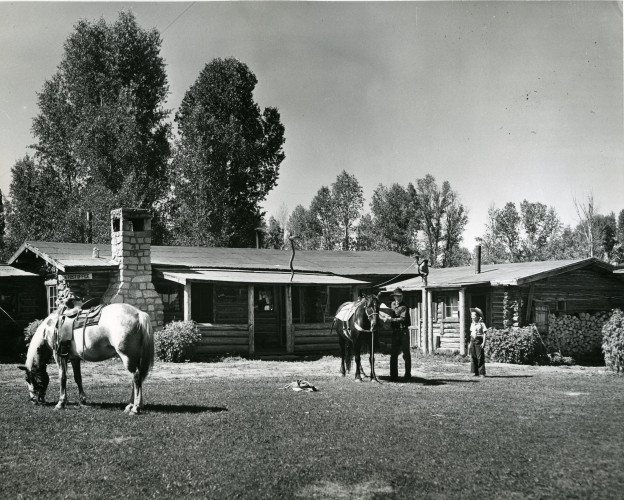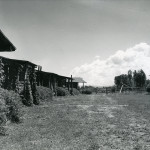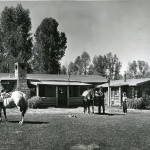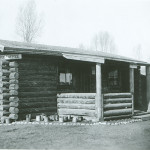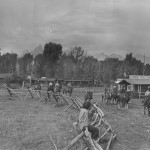- Dude cabins at Moose Head Ranch. Jackson Hole Historical Society and Museum
- Dudes outside the main lodge at the Moose Head Ranch. Jackson Hole Historical Society and Museum
- The Elk Post Office at the Moose Head Ranch. Jackson Hole Historical Society and Museum
- Pack trip leaving the Moose Head Ranch. Jackson Hole Historical Society and Museum
In 1927, Eva Sanford became one of the last individuals to file for a homestead on Spread Creek. Later that same year Calvin Coolidge signed Executive Order #4685 removing over 1,280 acres of public land from homestead claims. In 1930 the Sanford’s homestead was contested by the General Land Office, believing it to have been illegal due to the closure of public lands. An inspector was sent to review the property and the application, and found four cabins, a barn, chicken coop and garage. 19 acres had been cultivated and nearly 20 head of cattle and horses were on the property. The inspector determined that the homestead complied, and a patent was issued in 1931. It appears as though Eva’s determination to prove up on her land paid off, as there were too many improvements made to reverse the application.
Eva had arrived in the valley a year prior, escorted by her parents to become the new teacher at the Spread Creek School. She had up to 16 students, and taught first through eighth grade with two students in each grade. Despite being paid $90 a month (almost $10 more than the surrounding counties) most of her wages went toward her rent. To make ends meet, she worked on the nearby Cunningham Ranch and later for Rudy Harold, another neighbor. By December 16, 1931 when her homestead patent was approved, Eva was married to Fred Topping (a neighbor) and they both had built the modest beginnings of the Moose Head Ranch.
The tract of 120 acres of land that Eva filed on was surrounded by homesteads and ranches, so she had little work to do fencing her property. Between teaching and working for her neighbors, she had little time to construct a cabin of her own. When Eva and Fred were married, they both held homestead claims but had no cabin to live in. During the fall of 1928, Fred built a small cabin and they moved in before winter hit. A barn was added the next year, Rudy Harold gave them two dairy cows, Eva kept chickens and Fred bought eight head of horses. Fred had been working as a wrangler and hunting guide at the Bar BC, and JY Ranches, Eva tended the ranch and sold dairy, eggs and vegetables to the stores in Jackson. Fred’s reputation as one of the best guides in the valley garnered a following. Soon dudes from Bar BC, JY and even Sheffield’s Teton Lodge at Moran would only go on trips led by Fred. This gave Fred the idea of allowing hunters to lodge in tents on the Toppings property, a preferable arrangement to having to earn a living by working for someone else.
The tents, while cheap, were not suitable for the frigid late fall temperatures and the hunters couldn’t keep warm. Fall in 1930 came with -20 temperatures, which led Fred to add a kitchen and dining room on to his and Eva’s cabin, and one cabin for guests. They continued to add more guest cabins as demand increased. Despite the ranch opening during the Depression, the Toppings brought in a steady and loyal group of guests. Operations began to expand and by 1937, they officially called themselves the Moose Head Ranch. Like many others in the valley, the Toppings began the ranch intending to run cattle and horses, but soon found that wrangling dudes was far more lucrative. The Union Pacific listed the ranch in their “Dude Ranches Out West” pamphlet that was printed annually. For $35 a week, guests could enjoy “an old tub and shower baths,” main lodge dining room and lounge, fresh dairy and vegetables. The ability to grow vegetables and provide homemade dairy was a rarity on the earlier dude ranches in the valley. With such a short growing season, gardening was a limited activity. Horseback riding, hiking, fishing, and hunting trips were also offered. An additional option of $25 a week provided just room and board, without the saddle horse. It would appear the majority of the Moose Head’s following were hunters, and the ranch was never classified as a true “dude ranch” because it was not an operational cattle ranch.
The ranch soon could house up to 40 guests, but Eva found work as the postmaster for Elk, to bring in some cash. From 1932 until 1967, the Elk Post Office was stationed in its own cabin on the Moose Head Ranch. As was customary in Jackson Hole, when a schoolteacher was married, they brought in another teacher to carry on the duties. When the ranch that housed the Spread Creek School was sold to Grand Teton National Park, the school had to move. Eva allowed the building to be moved to the Moose Head, and it became known as the Elk School. The Toppings never charged the school rent.
At the end of 1967, the Toppings sold the ranch to John Mettler. Fred was in ill health, so the pair moved into Jackson. Fred later died in 1970, and Eva remained active in the Jackson social scene, working for several organizations. In 1972, she married William Briggs, but always looked back on her time at Moose Head fondly. Despite the challenging nature of ranching, it was rewarding to see all the hard work reflected in the success of the ranch and happiness of the guests. Today the Moose Head Ranch is still owned and operated by the Mettler family, and remains the only privately run dude ranch in Jackson Hole. Because the Toppings never sold their land to the Snake River Land Company or Grand Teton National Park, the ranch remains on private land.
Text by Samantha Ford, Director of Historical Research and Outreach



